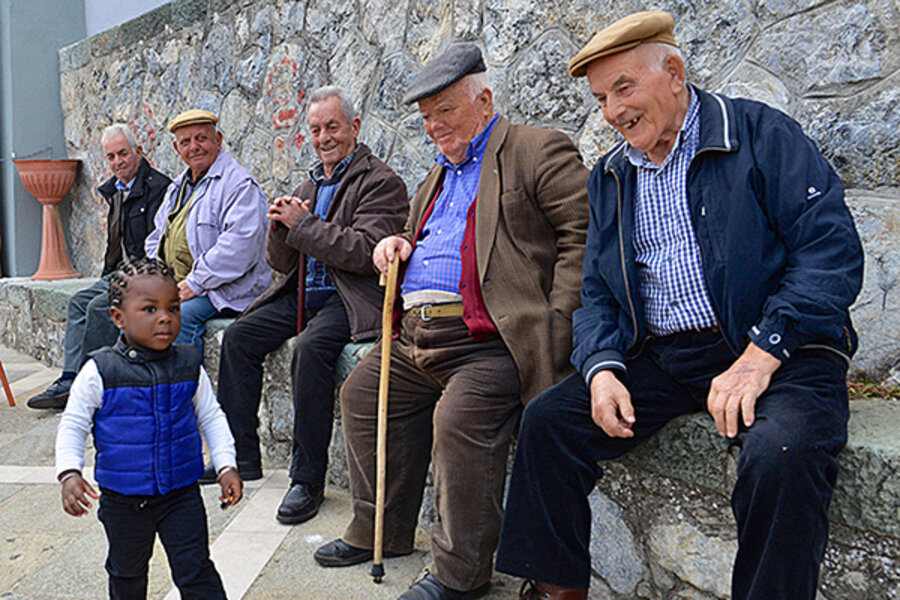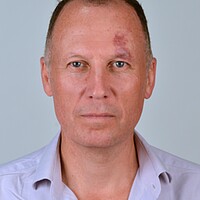Could embracing migrants help solve Italian villages' aging problem?
Loading...
| Acquaformosa, Italy
The past and future of the village of Acquaformosa, which sits on the edge of a national park in the mountains of southern Italy, were on vivid display recently in its sunlit main piazza.
On one side, pallbearers carried a coffin into a church, as a group of old men removed their flat caps in honor of their late friend. On the other, came recitations of Italian numbers and days of the week, being taught to a cosmopolitan group of asylum seekers from across Africa and the Middle East in a community center.
But the refugees are not simply temporary guests of Acquaformosa. They may also be the solution to its most pressing problem: depopulation.
For decades, young people have left the town, which lies beneath a forested mountain in the far south region of Calabria, to seek jobs elsewhere. They left behind an aging population.
But a few years ago Acquaformosa signed up to a government scheme under which struggling communities take in asylum seekers in return for government funding. The project has enabled the resuscitation of towns and villages that for years have faced precipitous demographic and economic decline.
Riace, a town further south in Calabria, was one of the first to adopt the scheme; its mayor, Domenico Lucano, was earlier this year named by Fortune magazine as one of the world’s 50 most inspiring leaders for his pro-refugee stance.
“We went to Riace to see how it all worked,” says Gennaro Capparelli, the mayor of Acquaformosa. “We then decided to sign up to the scheme. It has helped to address the problem of depopulation. With the arrival of the migrants and refugees, we’ve been able to revive local services. We’re undergoing a renaissance.”
'They take care of us'
The Italian state provides €24 ($26) a day, per person, to pay for their food and lodging – money that has injected new life into the town.
Acquaformosa’s experiences could provide a model for the rest of Italy, as it struggles to deal with the huge number of migrants and refugees reaching its shores from the coasts of North Africa – this year alone, more than 150,000 have arrived, on par with the refugee flow last year.
Many people in the town have an instinctive sympathy for refugees, a consequence of their unusual history. This rugged part of Calabria was settled in the Middle Ages by ethnic Albanians fleeing the Ottoman invasion of the Balkans. Many villages, including Acquaformosa, still speak an arcane dialect of Albanian known as Arbëresh. Heard in the streets, bars, and cafés, it is unintelligible to other Italians.
“We arrived as refugees, just like the migrants today. There is an understanding here, a willingness to help people who are in need,” says the mayor.
“They’re good people here, they take care of us,” says Tom, a Nigerian migrant who, like many migrants interviewed, did not want to give his last name.
In his home country he earned a living by installing PVC and aluminum windows and door frames, but says he had to leave after his union activities landed him in trouble with powerful politicians. Like many African migrants, he reached Italy in an overcrowded boat from the coast of Libya, where smugglers are making millions in trafficking people.
“If I can find work, I will stay here. I don’t want to run up and down the country. It’s very peaceful here, that’s the No. 1 thing,” he says.
Since joining the scheme a few years ago, Acquaformosa has welcomed about 350 asylum seekers from Syria, Somalia, Nigeria, Sudan, Eritrea, Chad, and Ivory Coast. Many have chosen to settle in the town.
“So many people have helped us here. This is a new life for us. We have to start all over again,” says Ahmed, who used to make a good living from a clothing factory near Damascus before it was destroyed in Syria’s civil war.
Since arriving here two years ago, he has found work with the local council, while his wife, Aida, who is originally from Tunisia, is employed as an interpreter and cultural intermediary.
Their two teenage sons go to the local school. It was down to just three pupils and under threat of closure, but with the arrival of the refugee children, its future is now assured.
Aida is not so sure that she wants to remain in Calabria forever. “I have dreams," she says. "We used to have a very nice lifestyle. I miss my work very much, and my friends – although most of them have been killed.”
A lack of jobs
While around 25 of the migrants and refugees are currently working for the council in various roles, others are struggling to find work. Employment opportunities have dried up around Acquaformosa in recent years – first a cigarette factory and then a textile manufacturer shut down. There is farming work, but it is highly seasonal.
“I came to Italy for a better life but if anything, it’s worse here. I can’t do anything. I just want to find a job so that I can support my family,” says Anthony Uwugbusun, a welder from Benin City, Nigeria, who has a five-month-old baby girl, Daniela. “If they can provide me with a job here, I will stay. If not, I will try to go to France or Germany.”
Despite the challenge of trying to provide work opportunities, other communities in Calabria are now following Acquaformosa’s lead, signing up to the migrant settlement program.
“A lot of towns and villages are realizing that welcoming migrants can provide jobs for their young people and revive their communities. Acquaformosa would be deserted if it was not for the migrants,” says Simonetta Bonadies, a psychologist who treats trauma and depression among the asylum seekers. “Having 100 extra people spending money in the bars and shops can make a real difference to the local economy.”
Still, some remain trenchantly opposed to the whole scheme.
“We don’t even have jobs for local people, let alone migrants. Calabria’s the poorest region in Europe,” said Victor, a pensioner who declined to give his last name. “I’d kick all the refugees out.”
But Larry Onaiwu, a Nigerian who now works for the council as a cultural mediator and interpreter, says he has encountered hostility from very few people. He was so grateful for being able to settle with his family in Acquaformosa that he named his second son Giovanni, after Giovanni Manoccio, a former mayor who pioneered the migrant scheme.
“There’s racism everywhere and there’s bound to be opposition,” he says, as his sons chatted to each other in fluent Italian and his wife, Blessing, cooked dinner in an apartment on the village’s main street. “But if I wasn’t happy, I’d be long gone. Here I have a chance to give something back to the system that has given so much to me.”








